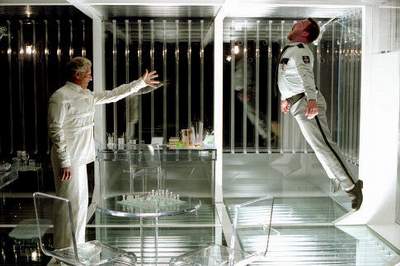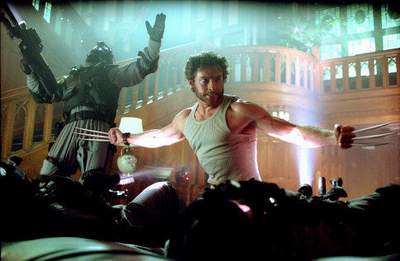X2: The Deviant Gene (A review of X-Men's sequel)
Bryan Singer's latest big-budget endeavour to animate Marvel's mutant superheroes on the silver screen offers a palatable helping of anti-human propaganda, despite its progressivist undertones.
With Joel Schumacher having cremated DC's Batman franchise in Batman Forever, the field is open for the real dons of the comic book - Marvel - to consolidate their long-overdue dominance of the silver screen. Bryan Singer's first X-Men film led the way in 2000, and with Sam Raimi's Spiderman last year, and the promise of Ang Lee’s Hulk to come, all the signs are that the painful memories of Marvel's forays into cinema and television in the seventies and early eighties might, at last, be laid to rest. Back then, film seemed to flatten out the superhero, subordinating its ultravivid vivacity to a dulling reality principle (who can recall the third-rate WWF-contender look of Thor in the Hulk TV specials without cringing with embarrassment?). Marvel's mighty heroes, so indomitable in print, fell victim time and again to the superheroes' most deadly nemesis: bathos.
With the first X-Men film, Singer showed that it was possible not only to bring Marvel characters to cinematic life, but to actually enhance and expand their mythos in so doing. Expectations are accordingly much higher for this sequel than they were for the original.

In X2, as in the first film, Singer plays out what has been Marvel's main theme since the sixties: the positivisation of mutation, the defence of the deviant against the normal. It's significant that Marvel's iconic figures - Spiderman in the sixties and the new X-Men in the eighties - were presented not as well-beloved civic institutions, but as semi-outcasts, distrusted and sometimes loathed by a sceptical public. The plot of X2 turns on anti-mutant hysteria, exploited and manipulated by Special Forces-type William Stryker (Brian Cox), who wants to subordinate or kill all mutants. Stryker's back story is that he is embittered against mutants because of his inability to deal with own son's telepathic powers. His son, Jason, labeled Mutant 143, is one of the new film's best innovations. Mutant 143 is a catatonic wreck straight out of early Gibson, described in the script as a 'shell of a man, shriveled and emaciated, sitting in a wheelchair. Syringes and tubes run from his head into clear containers on the back of his chair, continuously collecting the yellow fluid from his spinal column'.
Stryker represents the forces of reactive fear, organised against everything designated by the title's X: the novel, the anomalous and the unclassifiable. Like the teen, the mutant is located in-between: between human and animal, between the organic and the machinic, between child and adult. In Marvel, the teen body always emerges as an alien body, traversed and transformed by the technocultural energies of an onrushing future. One of the enjoyable subtexts in Raimi's Spiderman was the paralleling of body mutation with teen sexuality; consider, for example, the scene in which Aunt May nearly stumbles upon Peter in his bedroom, which is embarrassingly littered with emissions of his webbing, tell-tale signs that he is not the Peter she used to know. In X2, meanwhile, the mutant is paralleled with non-standard sexuality. One of the pivotal scenes has Bobby Drake (Iceman) returning home to his parents' house. They are under the misapprehension that he is at a normal prep school, and Bobby decides that now is the time to 'come out' as a mutant. There are some impressively uncomfortable moments, culminating in uneasy hilarity as Bobby's mother asks: 'Have you ever tried... Not being a mutant?' (A question echoed later by the timorous Nightcrawler, who enquires of Mystique why, if she has the power to look normal all the time, she doesn't. 'Because we shouldn't have to', she tartly replies.)
Sadly, the film overcodes the standard-versus-anomalous opposition with a somewhat passé, nineteenth-century notion of evolution as a linear progress: a voiceover at the close describes the mutants as the next stage in a process of inevitable improvement of the human (rather than as a deviation or secession from human history altogether). Ian McKellen's Magneto revels in the Nietzschean implications of this, with the same coolly seductive ubermenschian charm he displayed in the first film. 'We're gods amongst insects, never forget it', he memorably tells Pyro. Professor X presents the much less charismatic, liberal face of evolutionary progressivism. Like Pyro, I suspect most of the audience's libidinal investments will lie ultimately with Magneto's beyond-good-and-evil elitist pragmatism rather than with Xavier's more conventional rectitude.
The group dynamics of the X-men are inevitably better suited to the serial format of the comic rather than a one-off like the feature film. A film that necessarily features so many characters inevitably leaves you feeling disappointed: on the one hand, part of the thrill is seeing yet more well-known figures brought to cinematic realisation (Colossus, for instance, makes a tantalising, all-too brief appearance); on the other, you are left hungry for more focus on individuals. Still, the alleged fault that some critics have pointed to - that some characters are reduced to their powers - has its upside. Better that, than the gloomy pscychologism which has become so depressingly modish in post-Frank Miller comics and their adaptations (cf. Burton's overrated Batman films). And one of the great achievements of X2 is in giving the awesome, elemental force of the X-men's powers a convincing rendering. The opening sequence, in which a Stryker-controlled Nightcrawler speed-teleports into the Oval office amidst a hail of gunfire, is a fine example of this; as is the later optical-blasts-versus-telepathy face-off between Cyclops and Jean Grey.

If the film does focus on one character, it is the most arresting and celebrated of the X-men: Wolverine. Wolverine - part-animal, part-human, part-machine - is the very definition of the Harawayan cyborg. In X2, Wolverine’s primal scene - the hideous trauma of his lab-wrought transformation into an animal-fighting machine at the hands of a military research crew headed by Stryker - becomes crucial. Witnessed only in trauma-filtered flashbacks ('sometimes the mind has to discover things in its own way', Xavier tells him), these fragments provide some of the film's most intense scenes. X2 goes some way towards reclaiming Wolverine as one of the icons of cyberculture. (Question: were Wolverine's retractable claws the model for those of Molly Millions in Gibson's Neuromancer?).
X2 is a worthy sequel which - perhaps because of the standards Singer set in the first movie - does not quite pack the impact of its predecessor. The climax in particular - which manages to throw away the most tragic, and potentially dramatic, moment in either of the two films - is oddly underwhelming. Yet none of this has dulled the appetite for the next slice of big-budget anti-human propaganda. Bring on X3!
Mute Books Orders
For Mute Books distribution contact Anagram Books
contact@anagrambooks.com
For online purchases visit anagrambooks.com






